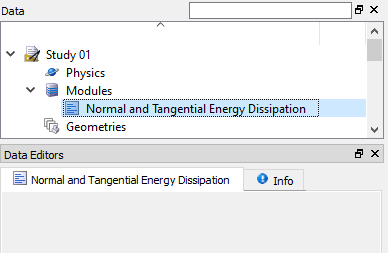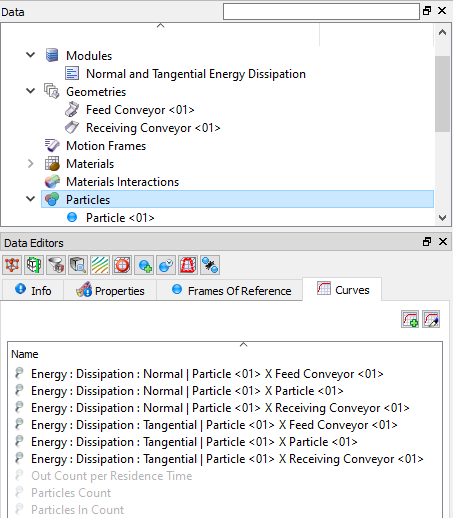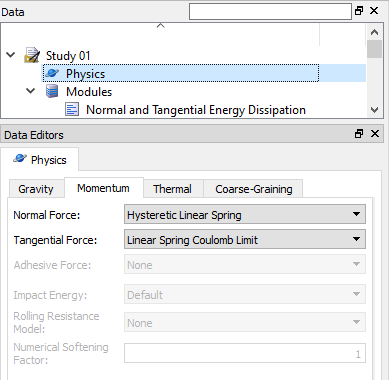The Normal and Tangential Energy Dissipation module re-implements and then splits into its normal and tangential components energy dissipation Curves and Properties that are currently provided in Rocky only as combined values. The Curves and Properties that this module is based upon are as follows:
The same Particle Curve calculations you get in Rocky when the Energy Dissipation option is enabled on the Inter-group Collision Statistics module (Figure 27.1: Inter-group Collisions Statistics module Curves upon which the Normal and Tangential Energy Dissipation module is based.)
Similar Particle Property calculations you get in Rocky when the Power option is enabled on the Inter-particle Collision Statistics module, only instead of power, it calculates energy (Figure 27.2: Inter-particle Collision Statistics module Property upon which the Normal and Tangential Energy Dissipation module is based.).
Figure 27.1: Inter-group Collisions Statistics module Curves upon which the Normal and Tangential Energy Dissipation module is based.
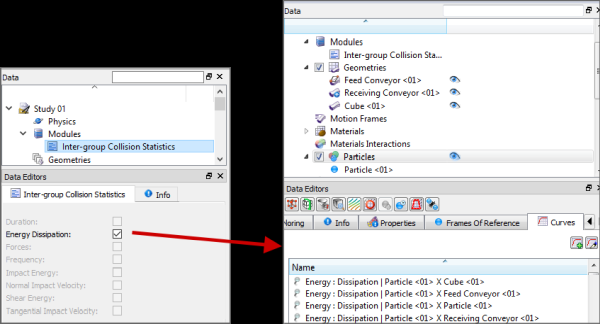
Figure 27.2: Inter-particle Collision Statistics module Property upon which the Normal and Tangential Energy Dissipation module is based.
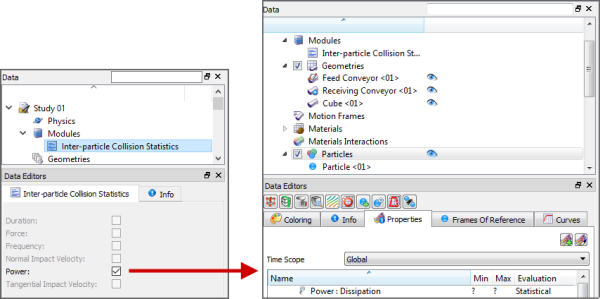
Neither of these two embedded Collisions Statistics modules need to be enabled in order for the Normal and Tangential Energy Dissipation module to work. Note: An embedded Module comes by default installed with the Rocky product. This kind of Module is documented in the User Manual and Technical manuals.
As in the embedded Collision Statistics modules, in the Normal and Tangential Energy Dissipation module, the dissipation energy is calculated computing the work of contact forces for all collisions during the simulation. But in this case, the work of normal and tangential components of contact forces is calculated separately.
Unlike the embedded Collision Statistics modules, the Normal and Tangential Energy Dissipation module does not compute energy dissipated by Adhesive Forces nor Rolling Resistance Torques.
This module has no parameters, as shown in Figure 27.3: Normal and Tangential Energy Dissipation module options.. There are also no additional settings to make anywhere else in the Rocky UI.
Once the Normal and Tangential Energy Dissipation module is enabled, the data for Inter-particle and Inter-group energy dissipation will be collected during simulation processing.
After processing, a new set of Curves for Inter-group dissipated energy and new Properties for Inter-particle dissipated energy are available. Refer to the sections below for further details.
Note: Properties generated by this module will only appear if the Upscaling is disabled.Refer to Rocky User Manual (5.1.7. About Meshed Particles Upscaling) for more details.
Several new Curves are available for the main Particles entity (Figure 27.4: Particles Curves created by the Normal and Tangential Energy Dissipation module.). These Curves are created for each particle-particle pair (Particle Group X Particle Group) and particle-geometry pair (Particle Group X Geometry).
The new Curves are explained below:
Energy: Dissipation: Normal: Provides the total energy dissipated by the normal component of contact forces for all collisions recorded for the indicated pair (particle-particle or particle-geometry) that occurred during an interval between two consecutive output times.
Energy: Dissipation: Tangential: Provides the total energy dissipated by the tangential component of contact forces for all collisions recorded for the indicated pair (particle-particle or particle-geometry) that occurred during an interval between two consecutive output times.
In addition, two new Properties for Inter-particle dissipated energy are available for the main Particles entity (Figure 27.5: Particles properties created by the Normal and Tangential Energy Dissipation module.).
The new Properties are explained below:
Energy : Dissipation : Normal: Provides the total energy dissipated by the normal component of contact forces for all collisions recorded for each individual whole particle or fragment that occurred during an interval between two consecutive output times.
Energy : Dissipation : Tangential: Provides the total energy dissipated by the tangential component of contact forces for all collisions recorded for each individual whole particle or fragment that occurred during an interval between two consecutive output times.
Ensure the module is enabled. (From the Data panel, select Modules and then from the Data Editors panel, ensure the Normal and Tangential Energy Dissipation checkbox is enabled.)
Set up your simulation as you normally would, keeping in mind the following:
When setting up your Physics parameters, remember that this module will not take into account the effects from Adhesive Forces and Rolling Resistance Torque. (In other words, if on the Physics | Momentum tab, you choose to define an Adhesive Force and/or a Rolling Resistance Model, this module will ignore those factors when generating its results.)
Process your simulation as you normally would.
When you are ready to analyze your simulation results, do the following:
From the Data panel, select the main Particles entity
Do either or both of the following:
From the Data Editors panel, select the Properties tab, and then display in a 3D View window or plot the and/or the Energy : Dissipation : Normal and/or the Energy : Dissipation : Tangential property.
From the Data Editors panel, select the Curves tab, and then plot the Energy : Dissipation : Normal and/or the Energy : Dissipation : Tangential Curves for the particleparticle or particle-group pair you want to analyze.
The primary source of energy dissipation during a collision is related to the inelastic
nature of the contact force. The dissipation work, , done by this force during a collision,
, is calculated as:
(27–1) |
where:
is the total contact force.
is the instantaneous relative velocity at the contact point.
The total contact force is given by the expression:
(27–2) |
where:
is the normal unit vector of the contact.
and
are, respectively, the normal and tangential components of the contact force, which are calculated forboth the Normal Force and Tangential Force contact models that you select on the Physics | Momentum tab (Figure 27.6: Normal Force and Tangential Force Contact Models.) for your Rocky project.
Combining equations [eq-work] and [eq-contact_force] yields:
(27–3) |
This way, the dissipation work done by the normal and tangential components of the contact force are, respectively:
(27–4) |
(27–5) |
Equations [eq:work_normal] and [eq:work_tangential] calculate the works of the normal
and tangential components of the contact force in a collision between two particles. In order
to calculate energy dissipated by each particle, the dissipated work of the collision must be
split between particles using a splitting factor, which is inversely
proportional to the particle/geometry stiffness. Thus, the works and
split between particle, A, and particle/geometry,
B, are given by the following expressions:
(27–6) |
(27–7) |
(27–8) |
(27–9) |
where is the Splitting factor, which is defined as:
(27–10) |
where and
are the stiffnesses attributed to particle A and
particle/geometry B, respectively.
The rationale behind this practice is that the energy dissipated during a collision by each one of the colliding entities will be proportional to its own deformation, which, in turn, will be inversely proportional to its stiffness.



